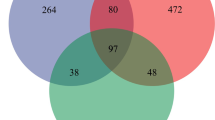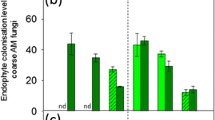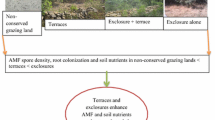Abstract
Liming is used to counteract forest decline induced by soil acidification. It consists of Ca and Mg input to forest soil and not only restores tree mineral nutrition but also modifies the availability of nutrients in soil. Ectomycorrhizal (ECM) fungi are involved in mineral nutrient uptake by trees and can recover them through dissolution of mineral surface. Oxalate and siderophore secretion are considered as the main agents of mineral weathering by ECMs. Here, we studied the effects of liming on the potential oxalate secretion and iron complexation by individual beech ECM root tips. Results show that freshly excised Lactarius subdulcis root tips from limed plots presented a high potential oxalate exudation of 177 μM tip−1 h−1. As this ECM species distribution is very dense, it is likely that, in the field, oxalate concentrations in the vicinity of its clusters could be very high. This points out that not only extraradical mycelium but also ECM root tips of certain species can contribute significantly to mineral weathering. Nonmetric multidimensional scaling (NMDS) separated potential oxalate production by ECM root tips in limed and untreated plots, and this activity was mainly driven by L. subdulcis ECMs, but NMDS on potential activity of iron mobilization by ECM root tips did not show a difference between limed and untreated plots. As the mean oxalate secretion did not significantly correlated with the mean iron mobilization by ECM morphotype, we conclude that iron complexation was due to either other organic acids or to siderophores.



Similar content being viewed by others
References
Agerer R (1987–1998) Colour atlas of ectomycorrhizae. Einhorn-Verlag Eduard Dietenberger, Munich
Agerer R (1991) Characterization of ectomycorrhiza. In: Norris JR, Read DJ, Varma AK (eds) Techniques for mycorrhizal research, vol. 23. Academic, San Diego, pp 25–73
Agerer R (2001) Exploration types of ectomycorrhizae: a proposal to classify ectomycorrhizal mycelial systems according to their patterns of differentiation and putative ecological importance. Mycorrhiza 11:107–114
Arvieu JC, Leprince F, Plassard C (2003) Release of oxalate and protons by ectomycorrhizal fungi in response to P-deficiency and calcium carbonate in nutrient solution. Ann For Sci 60:815–821
Bäckman JSK, Hermansson A, Tebbe CC, Lindgren PE (2003) Liming induces growth of a diverse flora of ammonia-oxidising bacteria in acid spruce forest soil as determined by SSCP and DGGE. Soil Biol Biochem 35:1337–1347
Brand F, Agerer R (1986) Studies on ectomycorrhizae viii. Mycorrhizae formed by Lactarius-subdulcis Lactarius vellereus and Laccarina amethystina on beech. Zeitschr Mykol 52:287–320
Buée M, Vairelles D, Garbaye J (2005) Year-round monitoring of diversity and potential metabolic activity of the ectomycorrhizal community in a beech (Fagus sylvatica) forest subjected to two thinning regimes. Mycorrhiza 15:235–245
Casarin V, Plassard C, Souche G, Arvieu JC (2003) Quantification of oxalate ions and protons released by ectomycorrhizal fungi in rhizosphere soil. Agronomie 23:461–469
Dancis A, Klausner RD, Hinnesbuch AG, Barriocanal JG (1990) Genetic evidence that ferric reductase is required for iron uptake in Saccharomyces cerevisiae. Mol Cell Biol 10:2294–2301
Dupouey JL, Thimonier A, Lefevre Y, le Tacon F, Bonneau M, Dambrine E, Poszwa A, Landmann G (1998) Desaturation and nitrogen enrichment of forest soils in north-eastern France in the last few decades. Revue Forestiere Francaise 50:391–402
Erland S, Taylor AFS (2002) Diversity of ectomycorrhizal fungal communities in relation to the abiotic environment. In: van der Heijden MGA, Sanders I (eds) Mycorrhizal ecology, ecological studies, vol 157. Springer, Berlin, pp 163–200
Frank J, Stuanes AO (2003) Short-term effects of liming and vitality fertilization on forest soil and nutrient leaching in a Scots pine ecosystem in Norway. For Ecol Manage 176:371–386
Gadd G (1999) Fungal production of citric and oxalic acid: importance in metal speciation, physiology and biogeochemical processes. Adv Microb Physiol 41:47–92
Gardes M, Bruns TD (1993) ITS primers which enhanced specificity for basidiomycetes—application to the identification of mycorrhizae and rusts. Mol Ecol 2:113–118
Gebauer G, Hahn G, Rodenkirchen H, Zuleger M (1998) Effects of acid irrigation and liming on nitrate reduction and nitrate content of Picea abies (L.) Karst. and Oxalis acetosella L. Plant Soil 199:59–70
Haas H (2003) Molecular genetics of fungal siderophore biosynthesis and uptake. The role of siderophores in iron uptake and storage. Appl Microbiol Biotechnol 62:316–330
Howard DH (2004) Iron gathering by zoopathogenic fungi. FEMS Immunol Med Microbiol 40:95–100
Ihaka R, Gentleman R (1996) R: a language for data analysis and graphics. J Comput Graph Stat 5:299–314
Jones DL, Dennis PG, Owen AG, van Hees PAW (2003) Organic acid behavior in soils—misconceptions and knowledge gaps. Plant Soil 248:31–41
Kalinowski BE, Liermann LJ, Givens S, Brantley LS (2000) Rates of bacteria-promoted solubilization of Fe from minerals. A review of problems and approaches. Chem Geol 169:357–370
Kraemer SM (2004) Iron oxide dissolution and solubility in the presence of siderophores. Aquat Sci 66:3–18
Kreutzer K (1995) Effects of forest liming on soil processes. Plant Soil 168:447–470
Landeweert R, Hoffland E, Finlay RD, Kuyper T, van Breemen N (2001) Linking plants to rocks. Ectomycorrhizal fungi mobilize nutrients from minerals. Trends Ecol Evol 16:248–254
Lapeyrie F, Chilvers GA, Bhem CA (1987) Oxalic acid synthesis by the mycorrhizal fungus Paxillus involutus Batsch. Ex Fr. Fr. New Phytol 106:139–146
Machuca A, Pereira G, Aguiar A, Milagres AMF (2007) Metal-chelating compounds produced by ectomycorrhizal fungi collected from pine plantations. Lett Appl Microbiol 44:7–12
Neilands JB (1984) Siderophores of bacteria and fungi. Microbiol Sci 1:9–14
Neilands JB (1995) Siderophores. Structure and function of microbial iron transport compounds. J Biol Chem 270:26723–26726
Persson T (1988) Effects of liming on soil fauna in forests. A literature review. Swed. Environ. Prot. Board Report. Rep. 3418
Prévost A, Pargney JC (1995) Comparaison des ectomycorrhizes naturelles entre le Hêtre (Fagus sylvatica) et 2 lactaires (Lactarius blennius var. viridis et Lactarius subdulcis). I. Caractéristiques morphologiques et cytologiques. Ann For Sci 52:131–146
Qian XM, Kottke I, Oberwinkler F (1998) Influence of liming and acidification on the activity of the mycorrhizal communities in a Picea abies (L.) Karst. Stand. Plant Soil 199:99–109
Raaska L, Mattila-Sandholm T (1995) Effects of iron level on the antagonistic action of siderophores from non-pathogenic Staphylococcus sp. J Ind Microbiol 15:480–485
Rambold G, Agerer R (1997) DEEMY—the concept of a characterization and determination system for ectomycorrhizae. Mycorrhiza 7:113–116
Reichard PU, Kretzschmar R, Kraemer SM (2007) Dissolution mechanisms of goethite in the presence of siderophores and organic acids. Geochim Cosmochim Acta 71:5635–5650
Rineau F, Garbaye J (2009) Effects of liming on ectomycorrhizal community structure in relation to soil horizons and tree hosts. Fungal Ecology 2:103–109
Rineau F, Garbaye J (2009) Does forest liming impact the enzymatic profiles of ectomycorrhizal communities through specialized fungal symbionts? Mycorrhiza 19:493–500
Rineau F, Courty PE, Uroz S, Buée M, Garbaye J (2008) Simple microplate assays to measure iron mobilization and oxalate secretion by ectomycorrhizal tree roots. Soil Biol Biochem 40:2460–2463
Rineau F, Maurice JP, Nys C, Voiry H, Garbaye J (2010) Forest liming durably impact the communities of ectomycorrhizas and fungal epigeous fruiting bodies. Ann. For. Sci 67:110–114
Schwyn B, Neilands JB (1987) Universal chemical assay for the detection and determination of siderophores. Anal Biochem 160:47–56
Smith SE, Read DJ (1997) Mycorrhizal symbiosis, 2nd edn. Academic, London, 606 pp
Szaniszlo PJ, Powell PE, Reid CPP, Cline GR (1981) Production of hydroxamate siderophore iron chelators by ectomycorrhizal fungi. Mycologia 73:1158–1174
Ulrich B (1983) Effects of acid deposition. In: Beilke S, Eshout AJ (eds) Acid deposition. Reidel, Dordrecht, pp 31–41
van Hees PAW, Godbold DL, Jentschke G, Jones DL (2003) Impact of ectomycorrhizas on the concentration and biodegradation of simple organic acids in a forest soil. Eur J Soil Sci 54:697–706
van Hees PAW, Jones DL, Jentschke G, Gobold DL (2005) Organic acid concentrations in soil solution: effects of young coniferous trees and ectomycorrhizal fungi. Soil Biol Biochem 37:771–776
van Hees PAW, Jones DL, Nyberg L, Holmström SJM, Godbold D, Lundström US (2005) Modelling low molecular weight organic acid dynamics in forest soils. Soil Biol Biochem 37:517–531
van Hees PAW, Rosling A, Essèn S, Godbold DL, Jones DL, Finlay RD (2006) Oxalate and ferricrocin exudation by the extramatrical mycelium of an ectomycorrhizal fungus in symbiosis with Pinus sylvestris. New Phytol 169:367–377
Wallander H (2000) Uptake of P from apatite by Pinus sylvestris seedlings colonised by different ectomycorrhizal fungi. Plant Soil 218:249–256
White TJ, Bruns T, Lee S, Taylor J (1990) Amplification and direct sequencing of fungal ribosomal RNA genes for phylogenetics. In: Innis MA, Gelfand DH, Sninsky JJ, White TJ (eds) PCR protocols: a guide to methods and applications. Academic, New York, pp 315–322
Winkelmann G (2002) Microbial siderophore-mediated transport. Biochem Soc Trans 30:691–696
Acknowledgments
We thank Dr. C. Nys for providing the experimental site of Humont and for his expertise about liming and the Office National des Forêts for allowing us to sample roots in the experimental plots. This work was made possible by grants from INRA and the Lorraine Region. We thank Marlis Reich for very useful help in molecular identification. J-L Churin and C. Delaruelle are also gratefully acknowledged for help and for their expertise about ectomycorrhizas and DNA sequencing, respectively. We also thank P. Frey-Klett, S. Uroz, P. E. Courty, M. Smits, and four anonymous reviewers for their useful comments.
Author information
Authors and Affiliations
Corresponding author
Electronic supplementary material
Below is the link to the electronic supplementary material.
Supplementary Table 1
Morphological description of the 25 ectomycorrhizal morphotypes encountered throughout the study. (DOC 138 kb)
Supplementary Table 2
Molecular identification of the ectomycorrhizal morphotypes. When molecular identification was successful, BLAST results are given in the table (accession number, score, and e-value). (PDF 10 kb)
Rights and permissions
About this article
Cite this article
Rineau, F., Garbaye, J. Effects of Liming on Potential Oxalate Secretion and Iron Chelation of Beech Ectomycorrhizal Root Tips. Microb Ecol 60, 331–339 (2010). https://doi.org/10.1007/s00248-010-9697-3
Received:
Accepted:
Published:
Issue Date:
DOI: https://doi.org/10.1007/s00248-010-9697-3




